Unusual Houseplants: 19 Unique Varieties to Grow at Home:
Unusual houseplants are becoming a growing trend among plant enthusiasts, adding personality and charm to indoor spaces. Unlike common greenery, these rare and visually striking plants bring unique colors, textures, and shapes that make your home feel like a living work of art.
From vibrant foliage to exotic vines, this list of 19 unusual houseplants includes rare gems that are both eye-catching and easy to care for. Whether you’re a seasoned collector or a beginner looking to add a statement plant to your space, these selections will elevate your indoor garden with minimal effort.
Get ready to discover unusual houseplants that will transform your home into a lush, one-of-a-kind retreat!
What Makes a Houseplant Unusual?
Unusual houseplants stand out from the typical greenery due to their distinct foliage, rare varieties, exotic origins, or unexpected growth habits. These plants go beyond the ordinary, offering unique textures, striking colors, or fascinating shapes that instantly catch the eye.
1. Rex Begonia Vine (Cissus discolor)

The Rex Begonia Vine is a breathtaking trailing plant known for its striking variegated leaves. The foliage features a rich green base with silvery patterns and deep burgundy undersides, making it a standout in any indoor garden. With a natural climbing habit, it thrives when trained on a trellis or left to cascade from a hanging basket.
Why It’s Unusual:
- Velvety, two-toned leaves that resemble Rex Begonia but belong to the grape family.
- Rapid growth with a vining habit, adding vertical interest indoors.
Care Tips:
- Light: Bright, indirect light to maintain vibrant leaf patterns.
- Water: Keep the soil slightly moist but avoid overwatering.
- Humidity: Prefers high humidity, making it ideal for terrariums or bathrooms.
- Support: Benefits from a trellis or moss pole for climbing.
This rare and eye-catching vine is perfect for plant lovers looking to add texture and movement to their indoor plant collection.
2. Rosary Vine (Ceropegia linearis subsp. woodii)
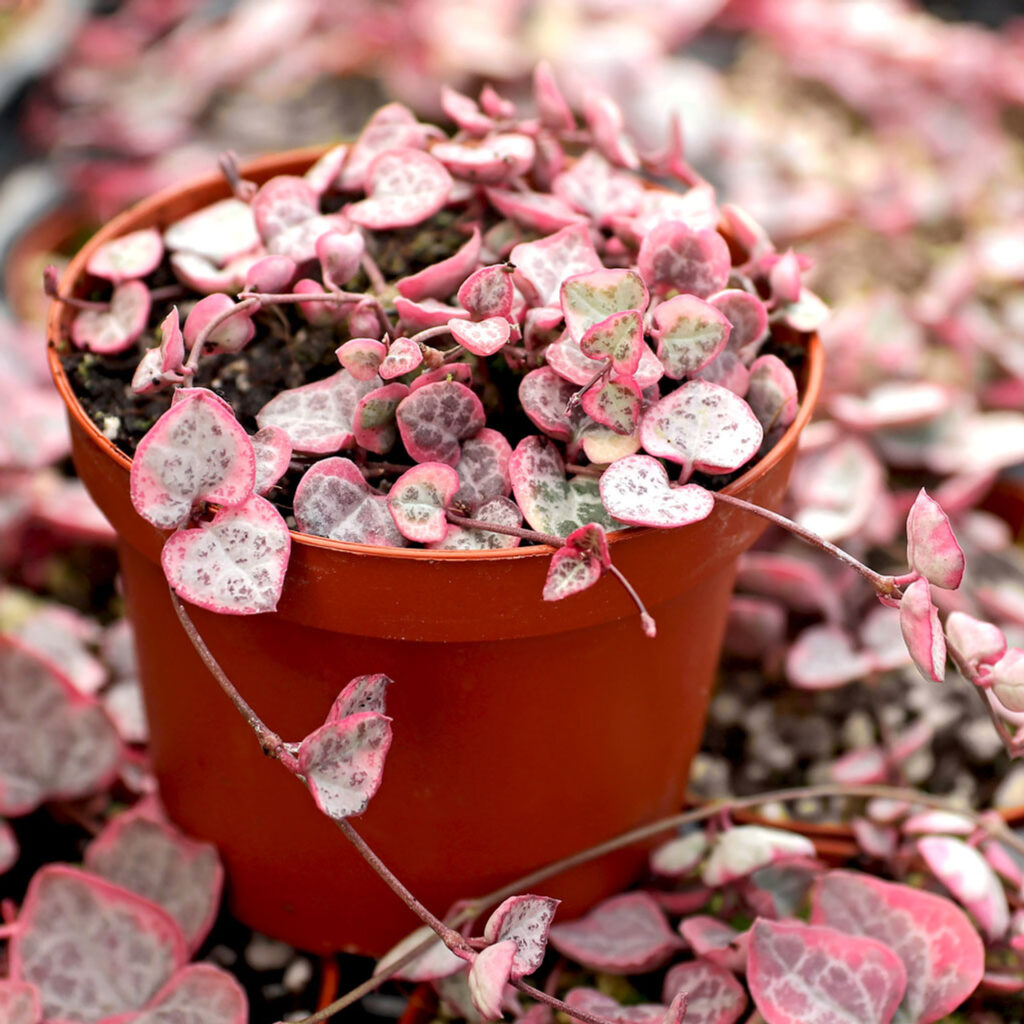
Also known as String of Hearts, the Rosary Vine is a delicate, trailing plant loved for its small, heart-shaped leaves with silvery marbling. The thin, cascading vines can grow several feet long, creating a graceful waterfall effect in hanging planters.
Why It’s Unusual:
- Unique heart-shaped foliage with a soft green and silver pattern.
- Produces tiny, bead-like tubers along the vines, resembling a rosary.
- Long, cascading growth habit that looks stunning in hanging baskets.
Care Tips:
- Light: Prefers bright, indirect light but can tolerate some direct sun.
- Water: Let the soil dry out between waterings; drought-tolerant.
- Humidity: Adapts to normal household humidity levels.
- Propagation: Easily propagated from stem cuttings or tubers.
This charming vine is low-maintenance yet visually striking, making it a great choice for adding an elegant, whimsical touch to your indoor garden.
3. Zebra Plant (Aphelandra squarrosa)

The Zebra Plant is a stunning tropical houseplant known for its bold, dark green leaves with striking white veins, resembling zebra stripes. In the right conditions, it produces vibrant yellow flowers that add an extra pop of color. Though a bit finicky, its dramatic appearance makes it a favorite among plant enthusiasts.
Why It’s Unusual:
- Distinctive striped foliage that adds a bold contrast to indoor spaces.
- Produces bright yellow bracts with small tubular flowers, resembling a golden crown.
- Prefers high humidity, making it a perfect fit for terrariums or well-maintained indoor gardens.
Care Tips:
- Light: Bright, indirect light; too much direct sun can scorch the leaves.
- Water: Keep soil consistently moist but not soggy; avoid letting it dry out completely.
- Humidity: Requires high humidity—mist regularly or use a pebble tray.
- Temperature: Prefers warmth; avoid drafts and sudden temperature changes.
The Zebra Plant’s dramatic foliage and striking flowers make it an exceptional centerpiece, adding a tropical flair to any indoor collection.
4. Buddha’s Temple (Crassula ‘Buddha’s Temple’)
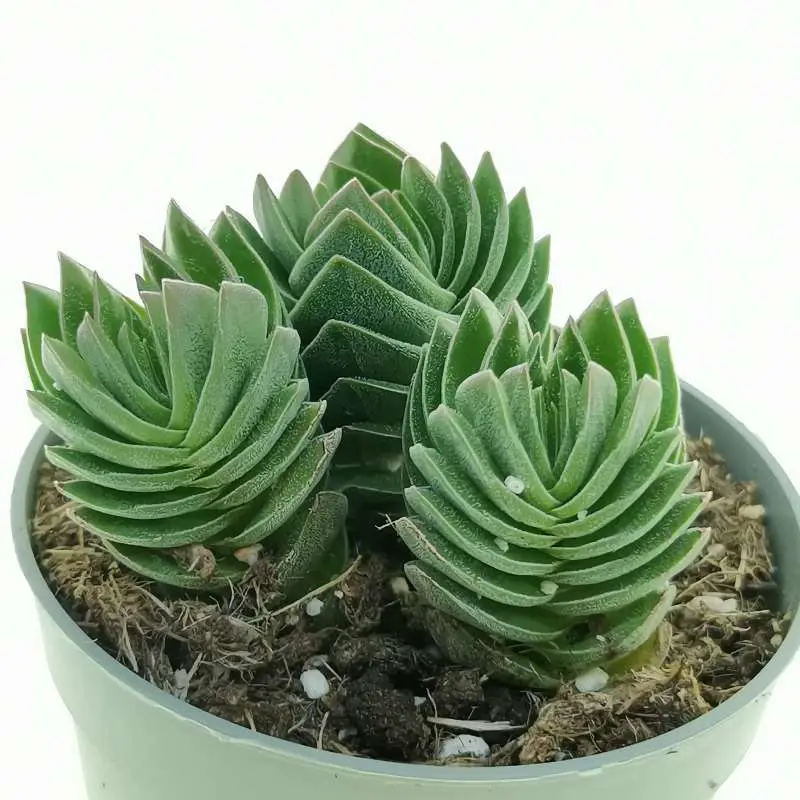
This fascinating succulent is a true architectural wonder, with its stacked, overlapping leaves forming a perfect square column that resembles a miniature temple. A hybrid of Crassula species, this plant is highly sought after for its geometric symmetry and sculptural appeal.
Why It’s Unusual:
- Unique stacked foliage with tightly layered, square-shaped leaves.
- Grows in a compact, upright form, resembling a miniature pagoda or temple.
- Produces small pink flowers at the top of mature plants.
Care Tips:
- Light: Prefers bright, indirect light to full sun.
- Water: Water sparingly; allow soil to dry completely between waterings.
- Humidity: Thrives in dry conditions; avoid excess moisture.
- Soil: Well-draining cactus or succulent mix to prevent root rot.
With its mesmerizing geometric shape and low-maintenance care, Buddha’s Temple is a must-have for succulent lovers and those who appreciate nature’s most artistic designs.
5. Watermelon Peperomia (Peperomia argyreia)
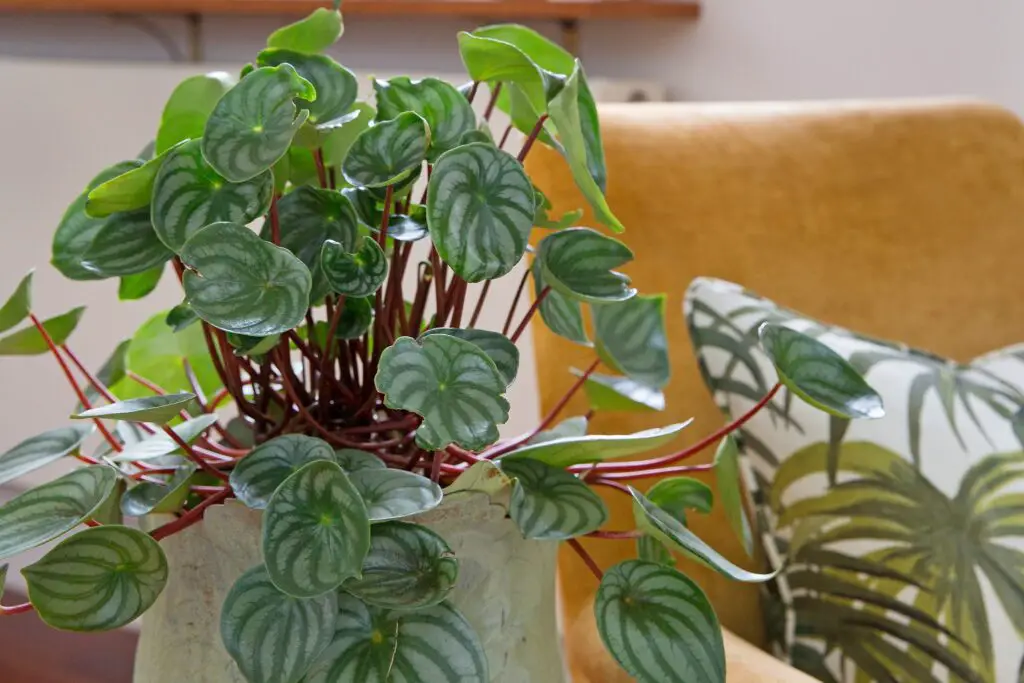
The Watermelon Peperomia is a charming houseplant prized for its round, glossy leaves that closely resemble the rind of a watermelon. Its compact size and eye-catching foliage make it a favorite among plant lovers looking for something unique yet easy to care for.
Why It’s Unusual:
- Leaves have silver-green stripes, mimicking the look of a watermelon.
- Compact, bushy growth makes it ideal for small spaces and tabletops.
- Thick, succulent-like leaves store water, making it more drought-tolerant than it appears.
Care Tips:
- Light: Prefers bright, indirect light; too much direct sun can fade leaf patterns.
- Water: Keep soil slightly moist but avoid overwatering; let the top inch dry out between waterings.
- Humidity: Enjoys moderate to high humidity but adapts to normal household levels.
- Temperature: Thrives in warm conditions; avoid cold drafts.
With its playful, watermelon-like appearance, this peperomia adds a fun and refreshing vibe to any indoor plant collection.
6. Black Bat Flower (Tacca chantrieri)

The Black Bat Flower is one of the most exotic and mysterious plants you can grow indoors. Known for its dramatic, bat-shaped black blooms with long, whisker-like filaments, this plant looks like something straight out of a fantasy world. Its deep green, tropical foliage adds to its striking appearance, making it a true conversation starter.
Why It’s Unusual:
- Produces dark, almost black flowers that resemble a bat in flight.
- Long, thread-like filaments extend from the flower, adding to its eerie beauty.
- Rare and exotic, making it a prized addition to any unique plant collection.
Care Tips:
- Light: Prefers bright, indirect light; avoid direct sun.
- Water: Keep soil consistently moist but not soggy.
- Humidity: Requires high humidity; mist regularly or use a humidity tray.
- Temperature: Thrives in warm, tropical conditions; avoid temperatures below 60°F (16°C).
With its otherworldly black blooms, the Black Bat Flower is a true showstopper, perfect for plant collectors who love the unusual and dramatic.
Related Topics:
7. Dancing Bones Cactus (Hatiora salicornioides)
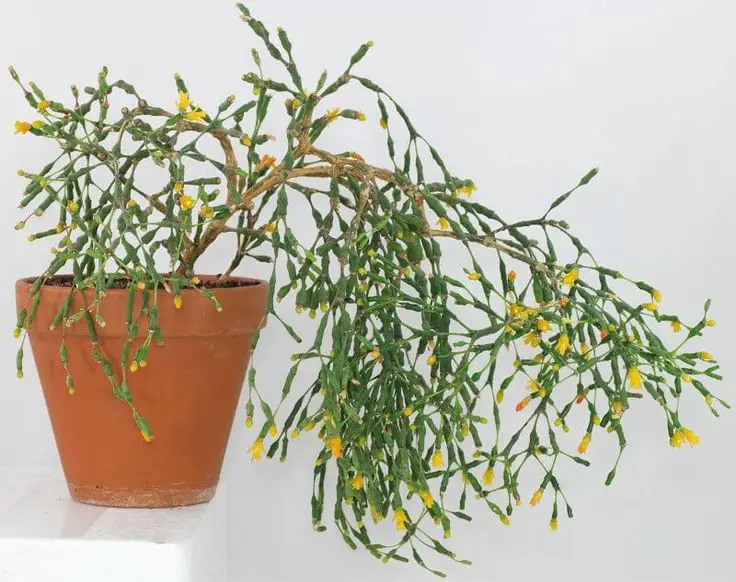
The Dancing Bones Cactus, also known as Drunkard’s Dream, is a quirky, eye-catching plant with thin, segmented stems that resemble a tangle of green bones. Despite being a type of cactus, it has a soft, almost whimsical appearance and produces bright yellow, bell-shaped flowers in the spring.
Why It’s Unusual:
- Unique jointed, cylindrical stems that give it a playful, dancing look.
- Produces cheerful yellow flowers, adding a pop of color.
- Unlike typical cacti, it thrives in humid conditions and does not have sharp spines.
Care Tips:
- Light: Prefers bright, indirect light but can tolerate some direct sun.
- Water: Keep soil lightly moist; allow the top layer to dry out between waterings.
- Humidity: Enjoys moderate to high humidity, making it ideal for bathrooms or kitchens.
- Temperature: Prefers warm conditions; protect from cold drafts.
With its unusual growth habit and cheerful blooms, the Dancing Bones Cactus adds a fun, lively touch to any indoor garden.
8. Night-Blooming Cereus (Epiphyllum oxypetalum)
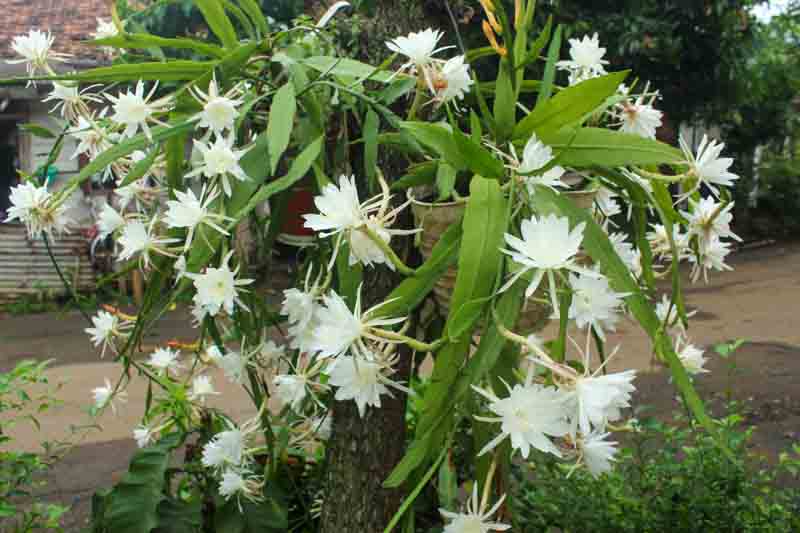
The Night-Blooming Cereus, also called the Queen of the Night, is a fascinating cactus known for its huge, fragrant white flowers that bloom only at night. These stunning blooms last just a few hours, making them a rare and magical sight for plant enthusiasts.
Why It’s Unusual:
- Produces massive, pure white flowers that can reach up to 12 inches across.
- Blooms only once a year, usually at night, filling the air with a sweet fragrance.
- Unlike desert cacti, it has broad, flattened stems instead of spines.
Care Tips:
- Light: Prefers bright, indirect light but can tolerate some direct morning sun.
- Water: Allow the top inch of soil to dry between waterings; avoid overwatering.
- Humidity: Thrives in moderate to high humidity levels.
- Temperature: Likes warm temperatures and should be protected from cold drafts.
With its rare and breathtaking nocturnal blooms, the Night-Blooming Cereus is a must-have for plant lovers who appreciate dramatic, once-in-a-year floral displays.
9. Lipstick Plant (Aeschynanthus radicans)

The Lipstick Plant is a vibrant, trailing houseplant known for its bold red tubular flowers that emerge from deep maroon buds, resembling a tube of lipstick. Its cascading vines and glossy green leaves make it a perfect choice for hanging baskets or shelves.
Why It’s Unusual:
- Unique red flowers that look like lipstick emerging from a tube.
- Long, trailing vines create a lush, cascading effect indoors.
- Blooms repeatedly in the right conditions, adding continuous color.
Care Tips:
- Light: Prefers bright, indirect light; too little light may reduce blooming.
- Water: Keep soil consistently moist but not soggy; allow the top inch to dry between waterings.
- Humidity: Thrives in high humidity; mist occasionally or use a pebble tray.
- Temperature: Prefers warm temperatures; avoid cold drafts.
With its playful, eye-catching flowers and lush trailing growth, the Lipstick Plant is a fun and exotic addition to any indoor garden.
10. Hoya Kerrii (Sweetheart Plant)
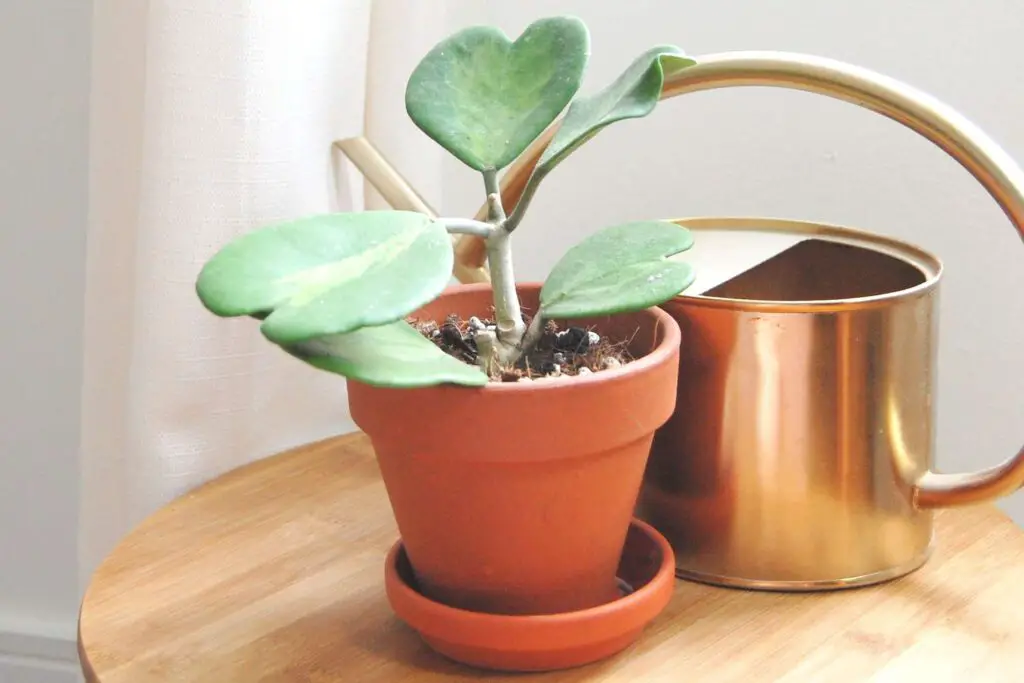
The Hoya Kerrii, commonly known as the Sweetheart Plant, is a charming and symbolic houseplant with thick, heart-shaped leaves. Often sold as a single leaf cutting, mature plants develop into trailing vines that produce fragrant, star-shaped flowers in clusters.
Why It’s Unusual:
- Heart-shaped leaves make it a perfect gift for plant lovers.
- A slow-growing but long-lasting succulent-like plant.
- Produces clusters of waxy, star-like flowers with a sweet fragrance.
Care Tips:
- Light: Prefers bright, indirect light; too much direct sun can scorch leaves.
- Water: Allow soil to dry out between waterings; drought-tolerant due to thick leaves.
- Humidity: Adapts well to household humidity levels.
- Temperature: Thrives in warm conditions; protect from cold drafts.
With its adorable foliage and fragrant blooms, the Sweetheart Plant is a delightful and low-maintenance addition to any indoor plant collection.
11. Pitcher Plant (Nepenthes spp.)
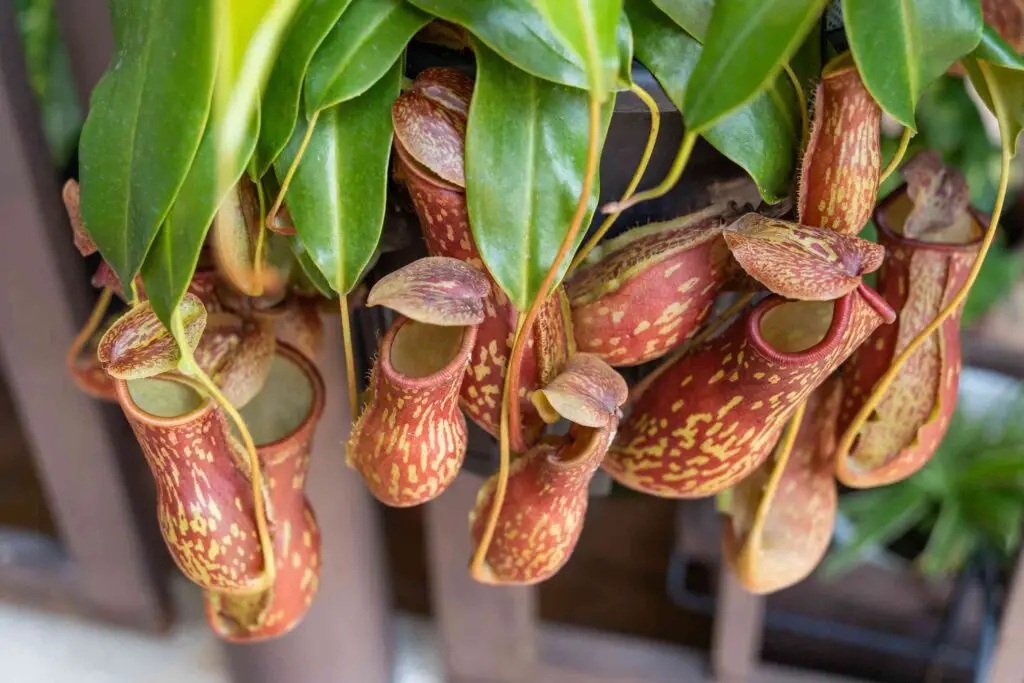
The Pitcher Plant is one of the most fascinating carnivorous plants, featuring hanging, pitcher-shaped traps that lure and digest insects. These unique, tube-like structures fill with digestive fluid, helping the plant extract nutrients from prey—making it both a functional and eye-catching addition to an indoor garden.
Why It’s Unusual:
- Carnivorous nature—traps and digests insects for nutrients.
- Stunning hanging pitchers in shades of red, green, and yellow.
- Exotic and rare, adding a touch of the wild to indoor spaces.
Care Tips:
- Light: Prefers bright, indirect light or partial sun.
- Water: Use distilled or rainwater; keep the soil moist but not soggy.
- Humidity: Requires high humidity (50%+); misting or a humidity tray helps.
- Feeding: Can catch its own food, but occasional feeding with small insects helps in low-bug environments.
With its striking appearance and insect-eating abilities, the Pitcher Plant is perfect for plant enthusiasts who love the unusual and exotic.
12. Living Stones (Lithops spp.)
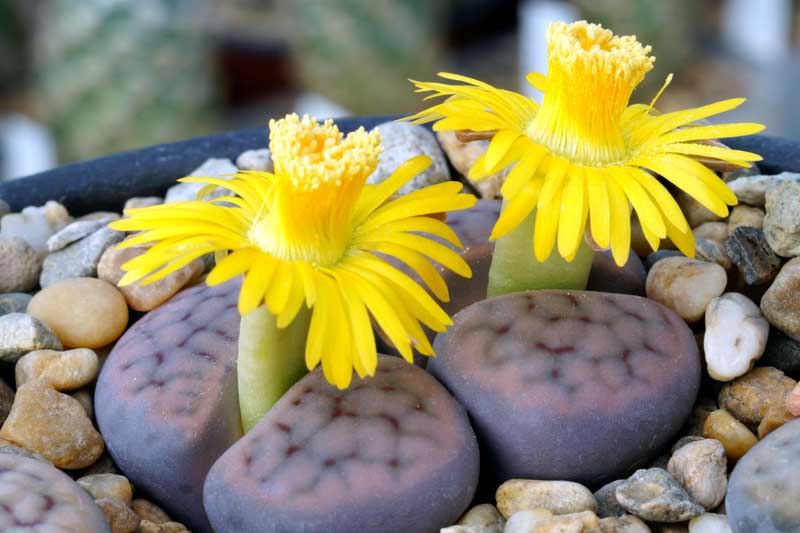
The Living Stones are a fascinating group of succulents that mimic small rocks or pebbles, helping them blend into their natural desert environment. Their compact, split-leaf structure allows them to store water efficiently, making them one of the most drought-tolerant plants you can grow indoors.
Why It’s Unusual:
- Rock-like appearance makes them look more like stones than plants.
- Extremely slow-growing and requires minimal care.
- Produces daisy-like flowers in shades of yellow or white.
Care Tips:
- Light: Prefers bright, direct sunlight; place in a sunny window.
- Water: Water sparingly—only when leaves start to wrinkle, typically every few months.
- Humidity: Thrives in dry conditions; avoid excess moisture.
- Soil: Use a very well-draining cactus mix with sand or perlite.
With their camouflaged look and quirky growth habit, Living Stones are a must-have for succulent lovers looking for something truly unique.
13. Corkscrew Albuca (Albuca spiralis)
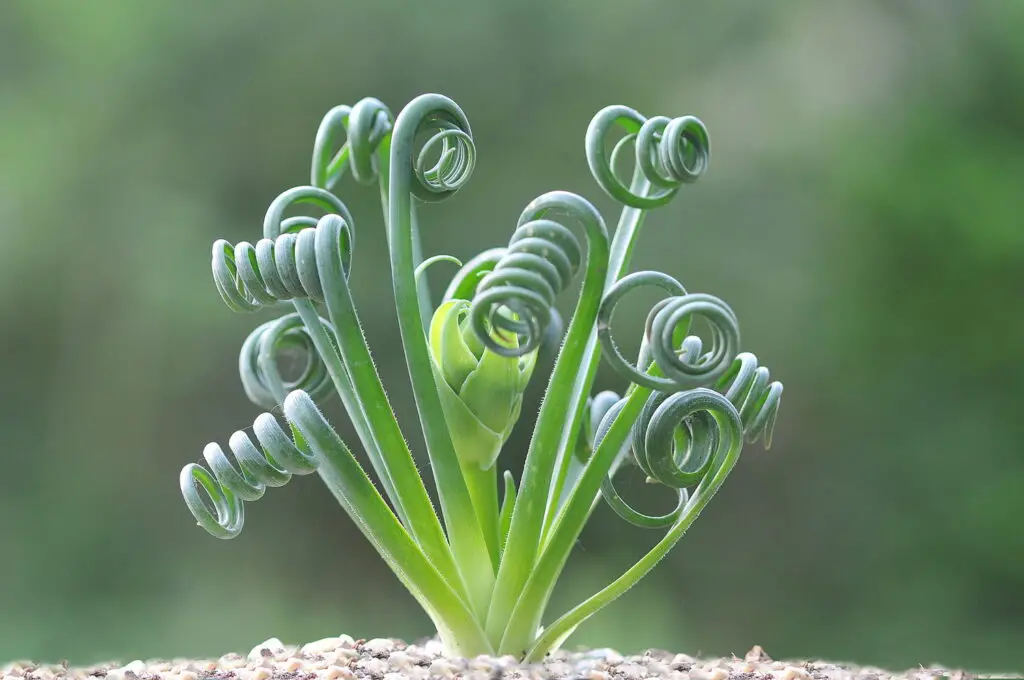
The Corkscrew Albuca, also known as Frizzle Sizzle, is a whimsical and unusual plant with thin, grass-like leaves that curl into spirals. This unique growth pattern, combined with its fragrant yellow flowers, makes it a standout in any plant collection.
Why It’s Unusual:
- Leaves naturally twist and curl like corkscrews.
- Produces sweetly scented yellow flowers in the spring.
- A bulbous plant that goes dormant in summer, adding seasonal interest.
Care Tips:
- Light: Prefers bright, direct sunlight to maintain tight curls.
- Water: Water sparingly; allow soil to dry between waterings.
- Humidity: Prefers low to moderate humidity.
- Dormancy: Leaves may die back in summer—reduce watering during this period.
With its playful, curly foliage and seasonal blooming cycle, the Corkscrew Albuca adds a fun and interactive element to an indoor garden.
14. Silver Vase Plant (Aechmea fasciata)
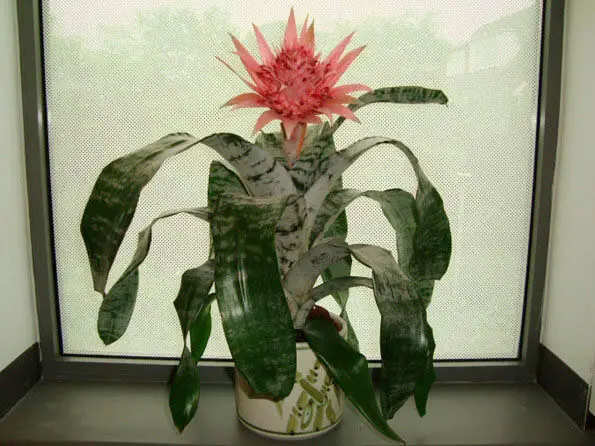
A striking bromeliad with silvery-green, arching leaves and a long-lasting pink flower bract. Its rosette-shaped foliage collects water, and it thrives as a low-maintenance indoor plant.
Why It’s Unique:
- Produces a stunning pink bloom with small blue or purple flowers.
- Has stiff, silver-coated leaves that form a natural water reservoir.
- Thrives on moisture collected in its central cup rather than direct soil watering.
Care Tips:
- Light: Prefers bright, indirect light. Can tolerate some direct sun.
- Water: Fill the central cup with water; refresh weekly. Keep soil lightly moist but not soggy.
- Humidity: Prefers moderate to high humidity; mist occasionally.
- Temperature: Prefers warm temperatures (65–80°F / 18–27°C). Avoid cold drafts.
With its architectural foliage and bold pink bloom, Aechmea fasciata makes a stunning statement piece in any indoor plant collection!
15. Rabbit’s Foot Fern (Davallia fejeensis)
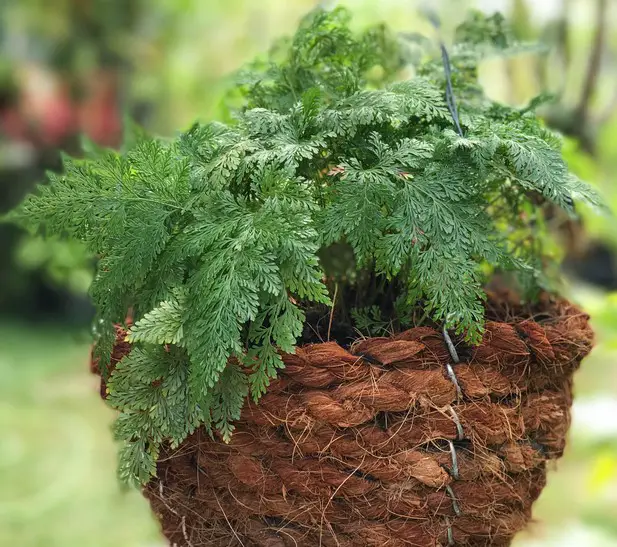
A delicate fern with lacy green fronds and soft, fuzzy rhizomes that creep over the soil like little rabbit feet. This epiphytic fern thrives in well-draining soil and brings texture and charm to any indoor space.
Why It’s Unusual:
- Distinctive furry rhizomes grow over the pot’s edge, resembling rabbit feet.
- Fronds are airy, feathery, and evergreen, providing year-round beauty.
- Adaptable and easy to care for, making it an excellent houseplant.
Care Tips:
- Light: Prefers bright, indirect light; tolerates some shade.
- Water: Keep soil consistently moist but not soggy. Avoid letting the rhizomes dry out completely.
- Humidity: Prefers moderate to high humidity; mist occasionally.
- Temperature: Thrives in warm temperatures (60–75°F / 16–24°C). Protect from cold drafts.
With its whimsical, creeping rhizomes and lush foliage, the Rabbit’s Foot Fern adds a playful and elegant touch to any plant collection.
16. Black Raven ZZ Plant (Zamioculcas zamiifolia ‘Raven’)
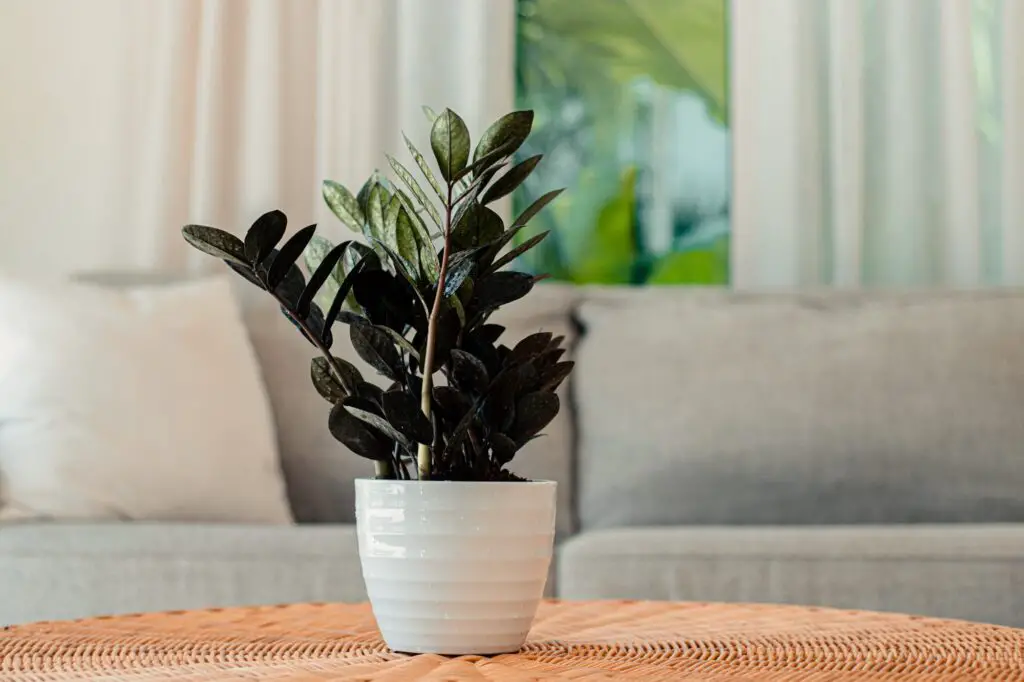
A striking, low-maintenance houseplant with glossy, deep purple-black leaves that emerge bright green before darkening with maturity. This dramatic plant is perfect for adding a bold, modern touch to any indoor space.
Why It’s Unusual:
- Leaves transition from vibrant green to near-black as they mature.
- Extremely drought-tolerant and can thrive in low light.
- A slow-growing yet highly resilient plant, perfect for beginners.
Care Tips:
- Light: Tolerates low to bright indirect light. Avoid direct sun.
- Water: Allow soil to dry out completely between waterings. Very drought-tolerant.
- Humidity: Adaptable to a range of humidity levels; thrives in average household conditions.
- Temperature: Prefers warm temperatures (65–80°F / 18–27°C). Avoid cold drafts.
With its glossy, jet-black foliage and easygoing nature, the Black Raven ZZ Plant makes a bold statement while requiring minimal effort.
17. Pencil Cactus (Euphorbia tirucalli ‘Firestick’)
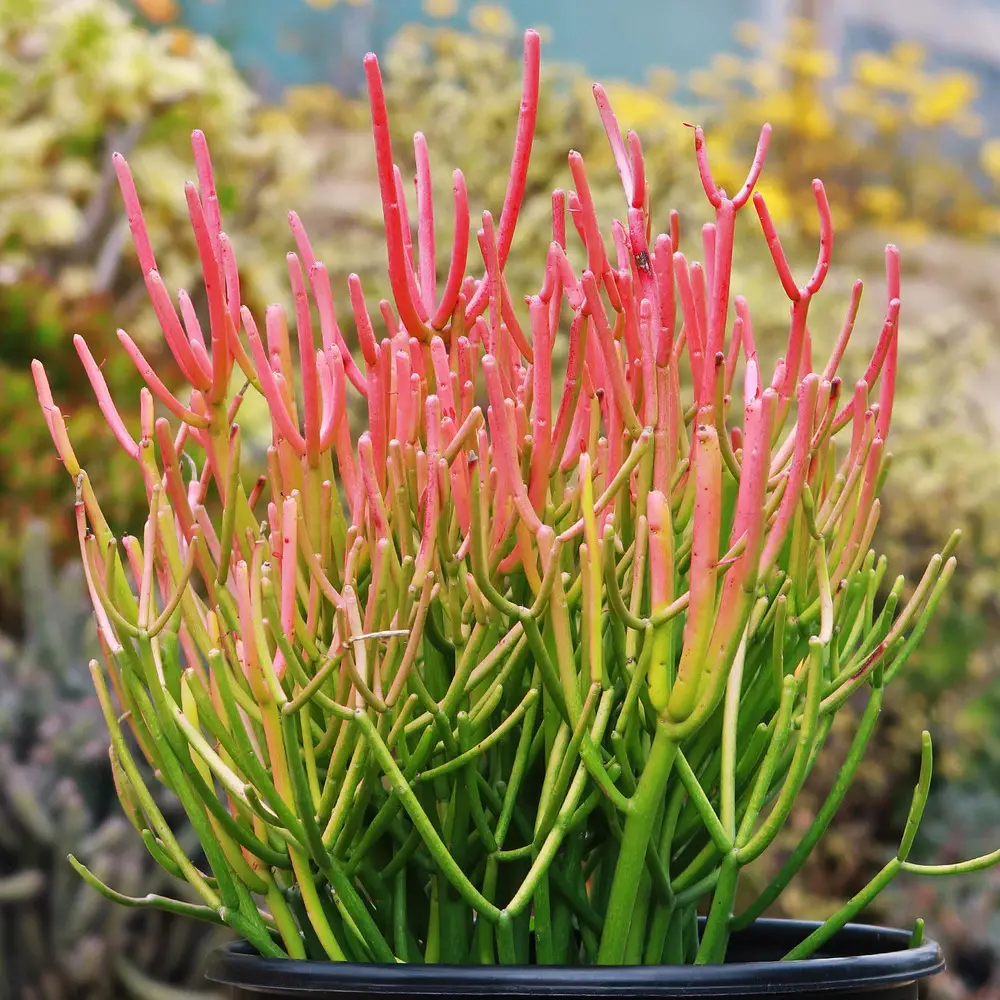
A striking succulent with slender, pencil-like stems that shift from green to fiery shades of red, orange, and yellow in bright sunlight. This dramatic, architectural plant adds a sculptural element to any indoor or outdoor space.
Why It’s Unusual:
- Color-changing stems glow in shades of red, orange, and yellow.
- Unique, branch-like growth pattern creates a modern, minimalist look.
- Drought-tolerant and thrives in harsh conditions with little care.
Care Tips:
- Light: Prefers bright, direct sunlight to enhance red hues.
- Water: Allow soil to dry out completely between waterings. Extremely drought-tolerant.
- Humidity: Thrives in dry conditions; avoid excessive moisture.
- Temperature: Prefers warm temperatures (65–85°F / 18–29°C). Protect from frost.
- Caution: Contains a milky sap that can be irritating to skin and eyes. Handle with care.
With its fiery colors and sculptural form, the Pencil Cactus ‘Firestick’ is a showstopper that brings warmth and vibrancy to any plant collection.
18. Chinese Money Plant (Pilea peperomioides)

A charming, easy-care houseplant with round, coin-like leaves that grow on long, slender stems, giving it a playful, airy appearance. Also known as the “Pass-It-On Plant” due to its tendency to produce baby offshoots.
Why It’s Unusual:
- Unique, pancake-shaped leaves create a striking, modern look.
- Produces small plantlets around its base, perfect for propagation.
- A symbol of good fortune and prosperity in feng shui.
Care Tips:
- Light: Prefers bright, indirect light but can tolerate some direct sun.
- Water: Water when the top inch of soil is dry; avoid overwatering.
- Humidity: Prefers moderate humidity but adapts to typical household conditions.
- Temperature: Thrives in 60–75°F (16–24°C). Protect from cold drafts.
- Rotation: Rotate regularly to encourage even growth.
With its quirky, round foliage and easy propagation, the Chinese Money Plant is a must-have for plant lovers looking to share their collection with friends.
19. Velvet Leaf Anthurium (Anthurium clarinervium)
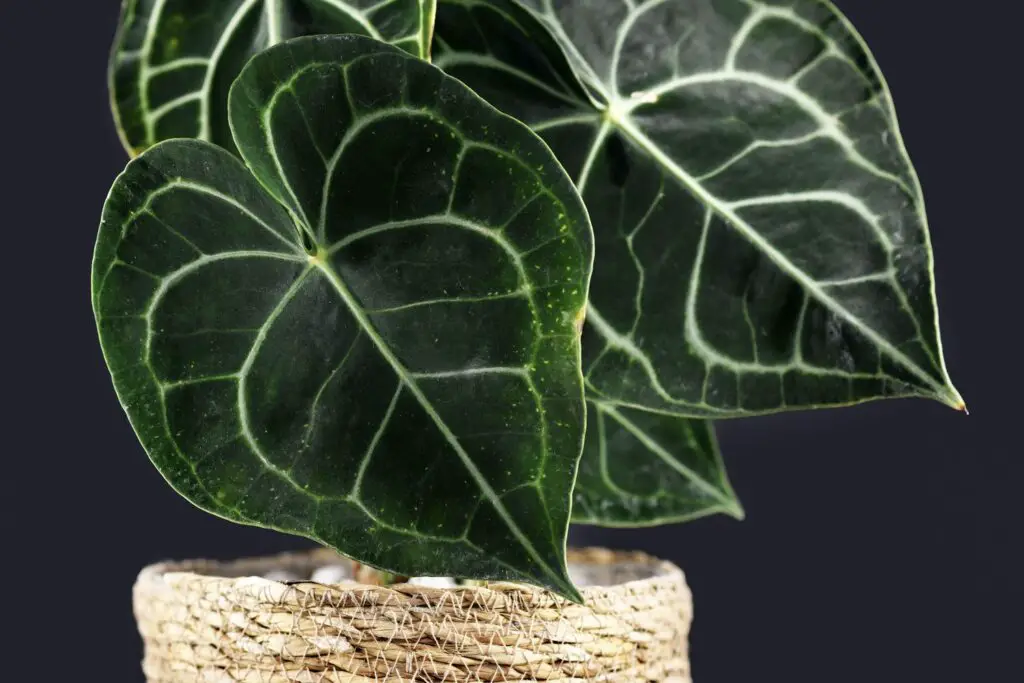
A stunning foliage plant with deep green, heart-shaped leaves covered in a velvety texture, accented by striking white veins. This luxurious plant adds a touch of elegance to any indoor space.
Why It’s Unusual:
- Velvety, suede-like leaves create a rich, dramatic look.
- Prominent white veins contrast beautifully against the dark green foliage.
- A slow-growing yet rewarding plant that thrives with proper care.
Care Tips:
- Light: Prefers bright, indirect light; avoid direct sun.
- Water: Keep soil evenly moist but not soggy; allow the top inch to dry between waterings.
- Humidity: Thrives in high humidity (60%+); mist or use a humidifier.
- Temperature: Prefers warm conditions (65–80°F / 18–27°C). Avoid cold drafts.
With its velvety leaves and bold contrast, the Velvet Leaf Anthurium is a true statement piece for plant enthusiasts who love unique texture.
Care Tips for Unusual Houseplants:
Unusual houseplants often require specific care to maintain their unique beauty and health. Here’s a guide to their general needs, special considerations, and the best placement for both aesthetic appeal and growth.
General Care Guidelines:
- Light: Most rare houseplants thrive in bright, indirect light. Some, like the Black Raven ZZ Plant, tolerate lower light, while sun-loving varieties like the Pencil Cactus ‘Firestick’ need direct sunlight to develop vibrant colors.
- Watering: Overwatering is a common issue. Many exotic plants, such as bromeliads like Aechmea fasciata, prefer water in their central cup rather than the soil. Succulents and drought-tolerant plants should dry out completely between waterings.
- Humidity: Tropical plants, including the Velvet Leaf Anthurium and Rabbit’s Foot Fern, thrive in high humidity. Consider misting, using a humidity tray, or placing them in naturally humid spaces like bathrooms.
Special Considerations for Rare and Exotic Varieties:
- Dormancy Cycles: Some plants, like the Corkscrew Albuca, go dormant in certain seasons and require reduced watering.
- Slow Growth: Unique plants such as the Silver Vase Plant and Chinese Money Plant may take time to mature, requiring patience.
- Handling Caution: Plants like the Pencil Cactus produce sap that can be irritating. Always wear gloves when handling certain species.
Best Placement Ideas for Aesthetic Appeal and Growth:
- Hanging Displays: Rosary Vine and Rabbit’s Foot Fern look stunning in hanging baskets where their trailing growth is highlighted.
- Statement Pieces: Bold plants like Black Raven ZZ and Velvet Leaf Anthurium make excellent focal points in living rooms or offices.
- Shelving & Tabletop Arrangements: Compact growers like the Chinese Money Plant and Silver Vase Plant add charm to bookshelves and coffee tables.
Where to Find These Unique Houseplants:
If you’re looking to expand your collection with rare and exotic houseplants, here are the best sources:
Specialty Plant Nurseries & Online Stores:
- Local Nurseries & Garden Centers: Some high-end nurseries carry unique varieties.
- Online Plant Shops: Websites like Etsy, specialty plant retailers, and even botanical gardens’ online stores often have rare selections.
- Plant Swaps & Communities: Local plant swaps and online groups (like Facebook Marketplace and Reddit plant communities) are great for finding rare plants and cuttings.
Tips for Ensuring Healthy Plant Purchases:
- Check for Pests: Inspect leaves and soil for signs of bugs before bringing plants home.
- Look at Root Health: If possible, check the roots—healthy roots should be firm and white or light brown, not mushy.
- Acclimate New Plants: Gradually introduce plants to their new environment, especially if they’ve been shipped.
By sourcing from reputable sellers and giving proper care, you’ll build a thriving collection of rare and beautiful houseplants!
Growing unusual houseplants is a rewarding way to bring diversity, texture, and striking visual appeal into your home. Whether it’s the velvety elegance of the Anthurium clarinervium, the dramatic hues of the Black Raven ZZ Plant, or the sculptural beauty of the Pencil Cactus ‘Firestick’, each unique plant adds character to your space while offering a fun and engaging care experience.
Exploring rare and exotic houseplants allows you to experiment with different care techniques, discover new growth patterns, and develop a deeper appreciation for the vast world of indoor greenery. Even if you’re just starting, there’s an unusual plant out there that will thrive in your space with a little attention and the right conditions.
Why not try adding one (or more) from the list to your collection? Step outside the ordinary and embrace the extraordinary with a plant that sparks your curiosity!
FAQs:
What are the easiest unusual houseplants to grow for beginners?
Some of the easiest unusual houseplants for beginners include the Black Raven ZZ Plant, Pencil Cactus, and Chinese Money Plant. These plants are low-maintenance, drought-tolerant, and can thrive in various indoor conditions.
Where can I buy unusual houseplants?
You can find unusual houseplants at specialty plant nurseries, online plant retailers, and local plant swaps. Websites like Etsy, The Sill, and rare plant marketplaces often have unique varieties available for purchase.
How do I care for rare and exotic houseplants?
The key to caring for rare houseplants is to research their specific needs. Most unusual plants thrive in bright, indirect light, require well-draining soil, and need controlled watering to prevent root rot. Humidity levels and proper placement can also affect their growth.

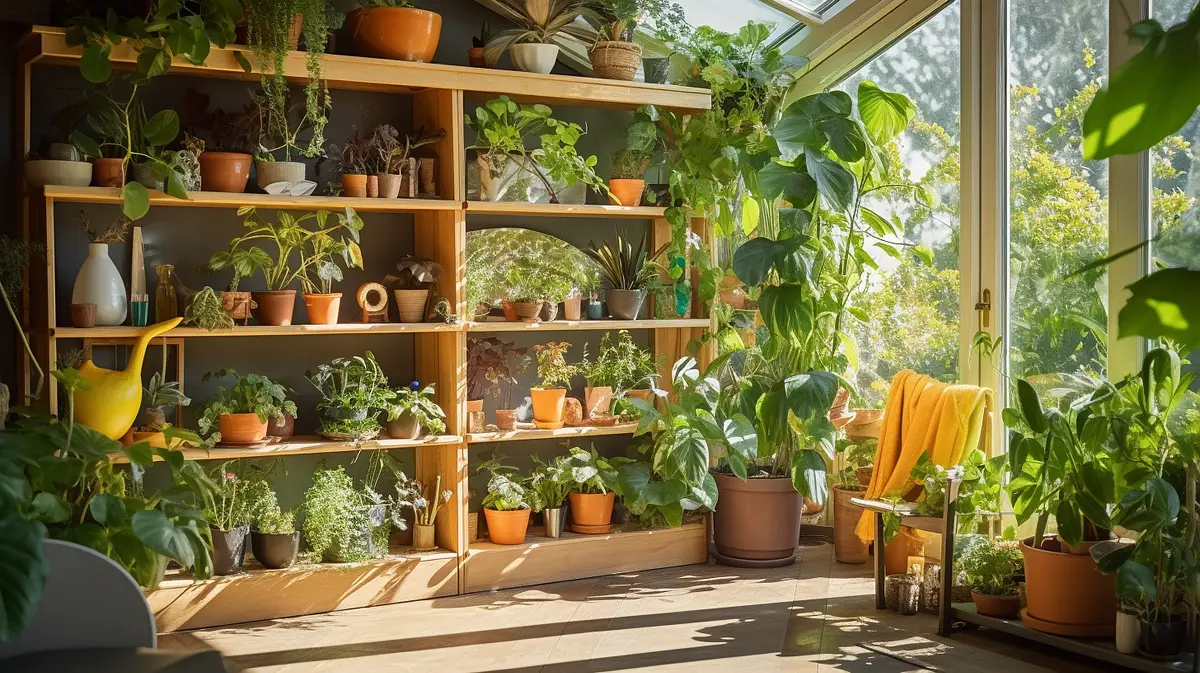
2 thoughts on “19 Unusual Houseplants To Grow At Home: Transform Your Indoor Jungle!”